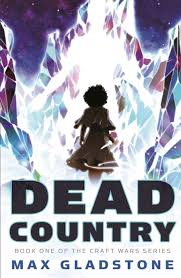 Max Gladstone’s Dead Country is the first in his The Craft Wars trilogy, and the 7th in his Craft series overall. Billed as a standalone subseries and an introduction to the characters, the volume starts with lead Tara Abernathy returning to the small town that wants pushed her out.
Max Gladstone’s Dead Country is the first in his The Craft Wars trilogy, and the 7th in his Craft series overall. Billed as a standalone subseries and an introduction to the characters, the volume starts with lead Tara Abernathy returning to the small town that wants pushed her out.
The early chapters make it quite clear that the town doesn’t trust her still, some being outright violently hostile while others seem to sympathize. Indeed she has only returned because of the death of her father, feeling A desperate need to say goodbye to the man. On her journey she finds an apprentice of her own, Dawn, attempting to protect her from similar harm and help to build her up as she would have liked. She also discovers that her hometown is beset by raiders and worse, artifacts of long past wars featuring super technology, the mystic, or some combination in between. All told it is an excellent setup that allows for lots of character delving and/or action in addition to nice solid segments of world building.
While putting this book in the fantasy genre is easy, choosing a sub-genre might be more difficult. There are many aspects of high or epic fantasy, yet the war blasted and broken setting will call to mind post-apocalyptic fantasy for many. This is even more likely with the presence of forgotten scientific facilities and relatively mundane names throughout the text. While this helps the setting field deeper, for those who wish to place fantasies in careful little boxes it may prove a small frustration.
Plenty of references are made to the lead heroine’s past, however due to the story taking her back to her hometown these do not feel like orphaned mentions from previous books. Instead they seem to be highlighting the way she had and had not grown over the course of her decades away, and highlight her own attempts to help others within that context.
Tara and her Apprentice Dawn are the most well fleshed out characters in The story, with figures like Tara’s mother and a local pastor as major characters otherwise. There is at least one romantic subplot in the book, strongly used and carefully interwoven into the text. That said it is not nearly enough major portion that anyone would argue the book was a romance, although it does lead to a delightful reversal of the damsel in distress archetype. The teacher student archetype that is used is much more complicated, certainly not following on simple patterns if only because the teacher is the individual being followed throughout the book.
For fans of Gladstone’s Craft series this volume is a must-read, in many ways upping the auntie and making clear just how strange the coming conflict will be. It is perfectly friendly to new readers, although one suspects that after finishing this volume more than a few will go back to look at the proceeding books. Overall it’s a quick breezy read with a open and rather dark ending. Fans of Hideyuki Kikuchi or Terry Brooks are likely to be especially fond of the world building, although Gladstone never seems like he is directly imitating another author.
(Tordotcom 2023)
